Search Result
Results for "
cell proliferation inhibition
" in MedChemExpress (MCE) Product Catalog:
1
Biochemical Assay Reagents
| Cat. No. |
Product Name |
Target |
Research Areas |
Chemical Structure |
-
- HY-N0644
-
-
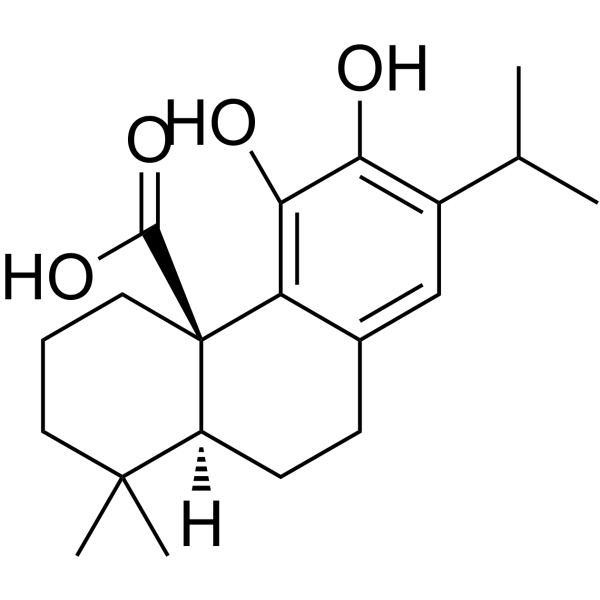
-
- HY-13748
-
Silybin A
Maximum Cited Publications
10 Publications Verification
Silibinin A
|
Autophagy
Reactive Oxygen Species
|
Cancer
|
|
Silybin A (Silibinin A), an effective anti-cancer and chemopreventive agent, has been shown to exert multiple effects on cancer cells, including inhibition of both cell proliferation and migration.
|
-
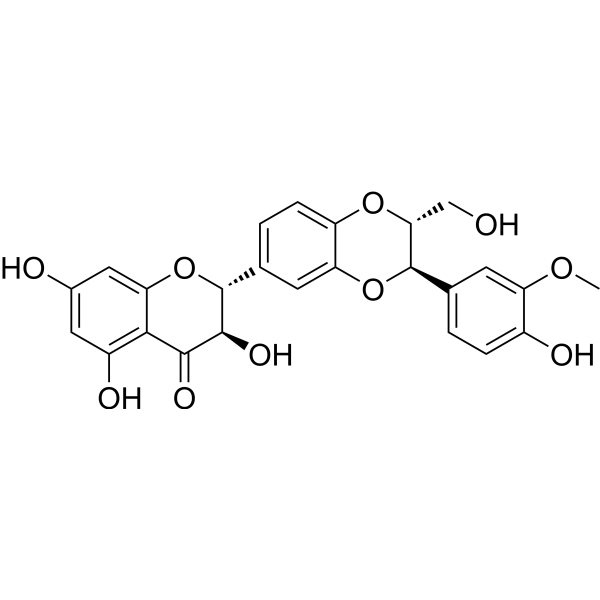
-
- HY-147655
-
|
|
Others
|
Cancer
|
|
CQ211 is a potent and selective RIOK2 inhibitor with a Kd of 6.1 nM. CQ211 exhibits potent proliferation inhibition activity against multiple cancer cell lines .
|
-
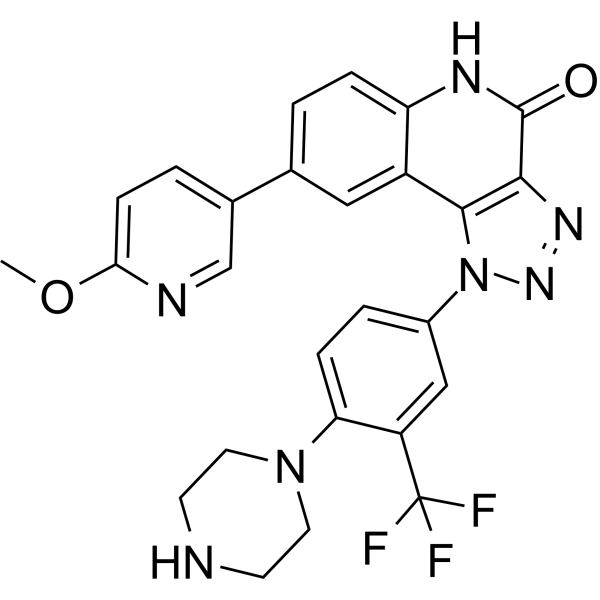
-
- HY-146380
-
|
|
Histone Demethylase
|
Cancer
|
|
S1427 is a tranylcypromine-derived LSD1 inhibitor with the IC50 of 390 nM and Ki of 80 nM. S1427 exhibits desirable hERG channel inhibition and microsomal stability profiles. Inhibition of LSD1 partially reduces the proliferation of cancer cells .
|
-

-
- HY-123786
-
|
|
Others
|
Cancer
|
|
NSC745887 (compound 25) is an anti-cancer agent. NSC745887 exhibits dose-dependent inhibition of proliferation in all 60 cancer cell lines .
|
-
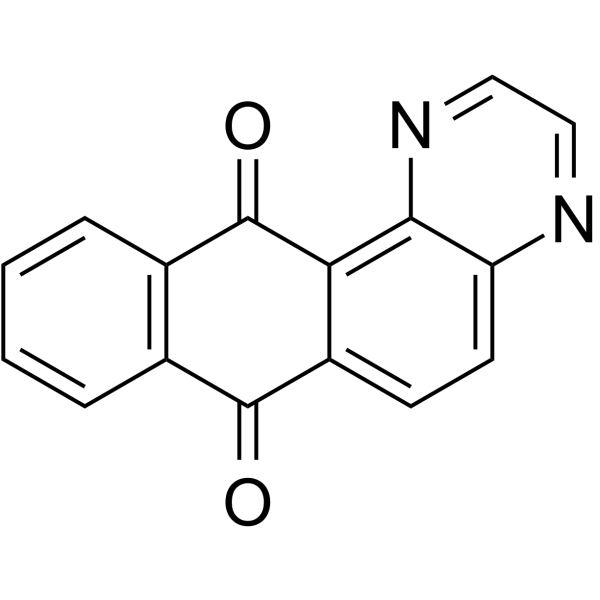
-
- HY-N1925
-
|
|
Apoptosis
Autophagy
|
Neurological Disease
Inflammation/Immunology
Cancer
|
|
Tea polyphenol is the floorboard of phenolic compounds in tea. Tea polyphenol exhibits biological activity including antioxidant and anti-cancer activities, inhibition of cell proliferation, induction of apoptosis, cell cycle arrest and modulation of carcinogen metabolism .
|
-
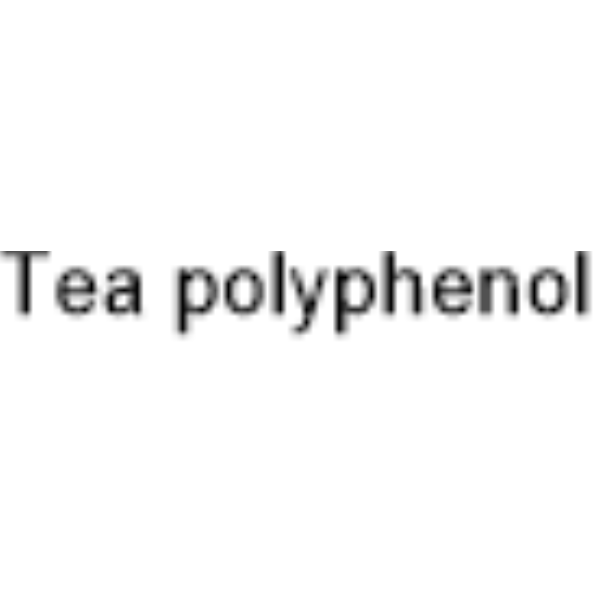
-
- HY-N0644R
-
|
|
Apoptosis
Bacterial
|
Cancer
|
|
Carnosic acid (Standard) is the analytical standard of Carnosic acid. This product is intended for research and analytical applications. Carnosic acid has demonstrated inhibition of oxidative stress and inflammation, suppression of cell proliferation, and antibacterial activity .
|
-
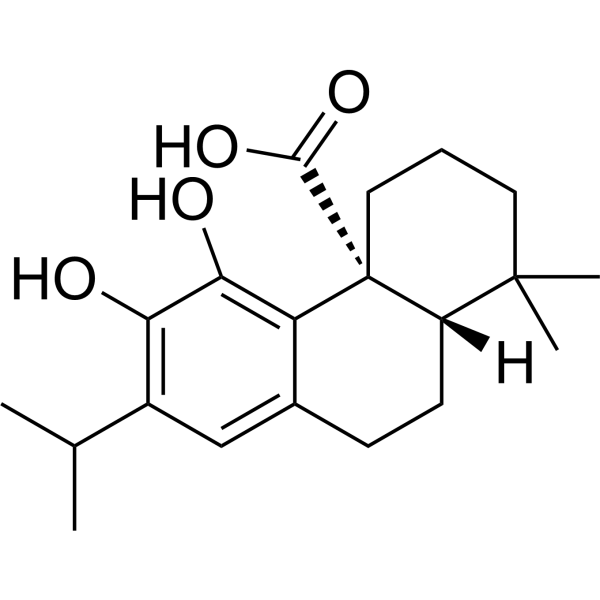
-
- HY-134575
-
|
|
Apoptosis
GSK-3
|
Others
|
|
C24:1-Ceramide is one of the most abundant naturally occurring ceramide. Ceramides regulates many diverse biological activities, such as cell apoptosis, cell differentiation, proliferation of smooth muscle cells, and inhibition of the mitochondrial respiratory chain .
|
-

-
- HY-N6036
-
|
|
Others
|
Cancer
|
|
Ganoderic acid F is a ganoderic acid. Ganoderic acid F exhibits antitumor and antimetastatic activities through inhibition of angiogenesis and alteration of proteins involving cell proliferation and/or cell death, carcinogenesis, oxidative stress, calcium signaling, and endoplasmic reticulum stress .
|
-
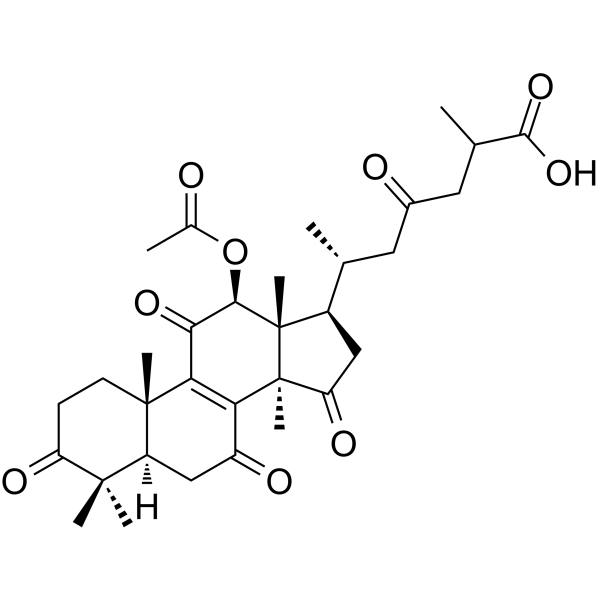
-
- HY-156266
-
|
Rhiz
|
Others
|
Cancer
|
|
Rhizochalinin (Rhiz) is a cytotoxic sphingolipid. Rhizochalinin (Rhiz) counteracts glioblastoma cell proliferation by inducing apoptosis, G2/M-phase cell cycle arrest, and inhibition of autophagy. Rhizochalinin (Rhiz) can be used for human glioblastoma research .
|
-
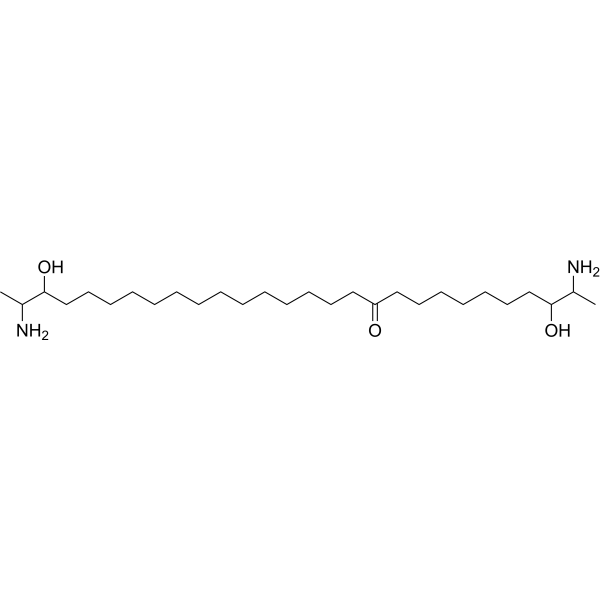
-
- HY-141703
-
|
|
Epigenetic Reader Domain
|
Cancer
|
|
DC-BPi-11 is an inhibitor of bromodomain PHD finger transcription factor (BPTF), with an IC50 value of 698 nM. DC-BPi-11 shows remarkable inhibition against leukemia cell proliferation .
|
-
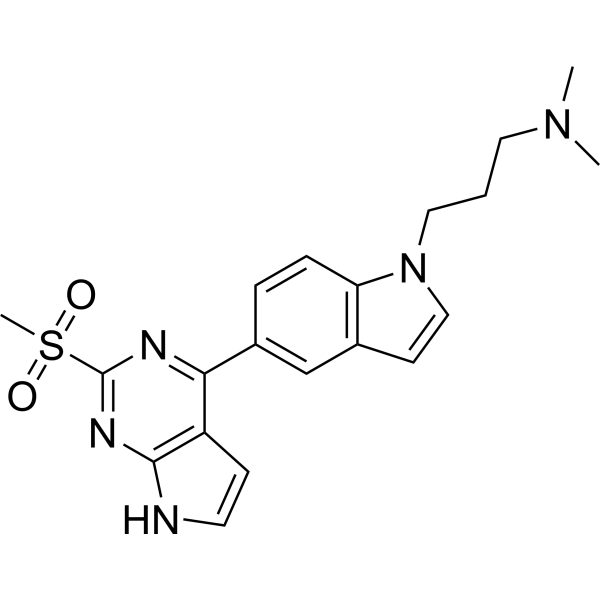
-
- HY-141703A
-
|
|
Epigenetic Reader Domain
|
Cancer
|
|
DC-BPi-11 hydrochloride is an inhibitor of bromodomain PHD finger transcription factor (BPTF), with an IC50 value of 698 nM. DC-BPi-11 hydrochloride shows remarkable inhibition against leukemia cell proliferation .
|
-
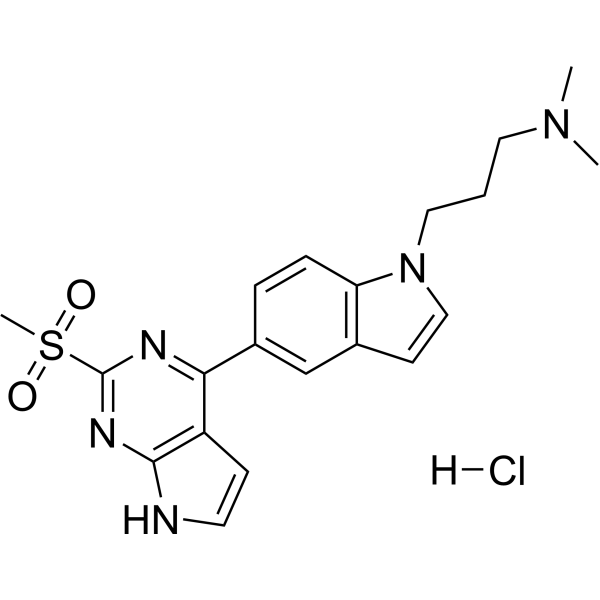
-
- HY-122928
-
|
|
Apoptosis
Caspase
|
Cancer
|
|
Rosamultic acid is an A-ring contracted triterpene, that can be isolated from the roots of Rosa rnultiflora. Rosamultic acid inhibits gastric cancer cells proliferation by inducing apoptosis mediated through cell cycle arrest, downregulation of cell cycle related protein expressions, inhibition of cell migration, DNA damage, and activation of caspases .
|
-

-
- HY-147861
-
|
|
Topoisomerase
Apoptosis
|
Cancer
|
|
Topoisomerase II inhibitor 11 (compound 3d) is a potent Topoisomerase II inhibitor, with an IC50 of 2.89 μM. Topoisomerase II inhibitor 11 shows 92.46% inhibition on renal cancer cell line A498 with an IC50 of 3.5 μM. Topoisomerase II inhibitor 11 causes cell cycle arrest at the G2/M phase leading to cell proliferation inhibition and pro-apoptotic activity .
|
-

-
- HY-108602
-
|
|
PKC
|
Cancer
|
|
Bryostatin 3, a macrocyclic lactone, is a protein kinase C activator, with a Ki of 2.75 nM. Bryostatin 3 can block 12-O-tetradecanoylphorbol-13-acetate (TPA) inhibition of cell proliferation, yet did not block TPA-enhanced cell-substratum adhesion .
|
-

-
- HY-12960
-
|
FLT3-IN-1
|
FLT3
c-Kit
Apoptosis
|
Cancer
|
|
SKLB4771 is a potent and selective Flt3 inhibitor with an IC50 value of 10 nM. SKLB4771 downregulates the phosphorylation of FLT3/STAT5/ERK, blocks cell proliferation, and induces apoptosis in tumor tissue .
|
-

-
- HY-15003
-
|
|
FLT3
Apoptosis
|
Cancer
|
|
ATH686 is a potent, selective and ATP-competitive FLT3 inhibitor. ATH686 target mutant FLT3 protein kinase activity and inhibit the proliferation of cells harboring FLT3 mutants via induction of apoptosis and cell cycle inhibition. ATH686 has antileukemic effects .
|
-

-
- HY-145849
-
|
|
VEGFR
|
Cancer
|
|
VEGFR2-IN-1 is a potent and selective VEGFR2 inhibitor (IC50=19.8 nM). VEGFR2-IN-1 inhibits cell proliferation and migration through apoptosis activation and VEGFR2 inhibition .
|
-
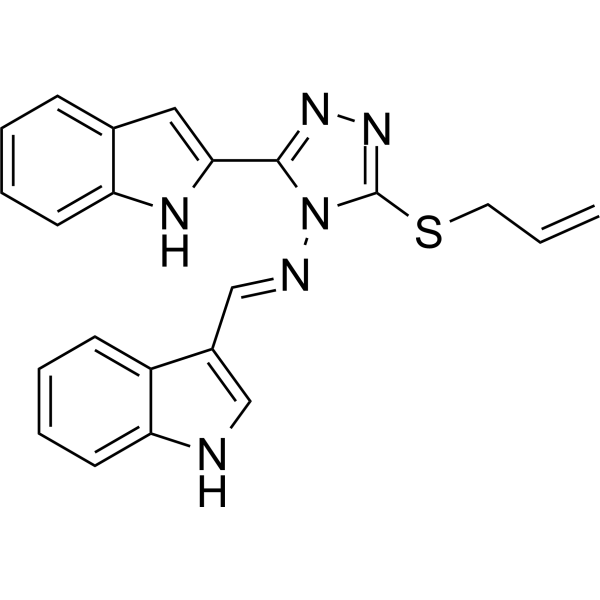
-
- HY-N2484
-
|
Astrapterocarpan
|
PDGFR
ERK
|
Cardiovascular Disease
|
|
Methylnissolin (Astrapterocarpan), isolated from Astragalus membranaceus, inhibits platelet-derived growth factor (PDGF)-BB-induced cell proliferation with an IC50 of 10 μM. Methylnissolin inhibits PDGF-BB-induced phosphorylation of extracellular signal-regulated kinase 1/2 (ERIC1/2) mitogen-activated protein (MAP) kinase. Methylnissolin inhibits PDGF-BB-induced vascular smooth muscle cell proliferation by inhibition of the ERK1/2 MAP kinase cascade .
|
-
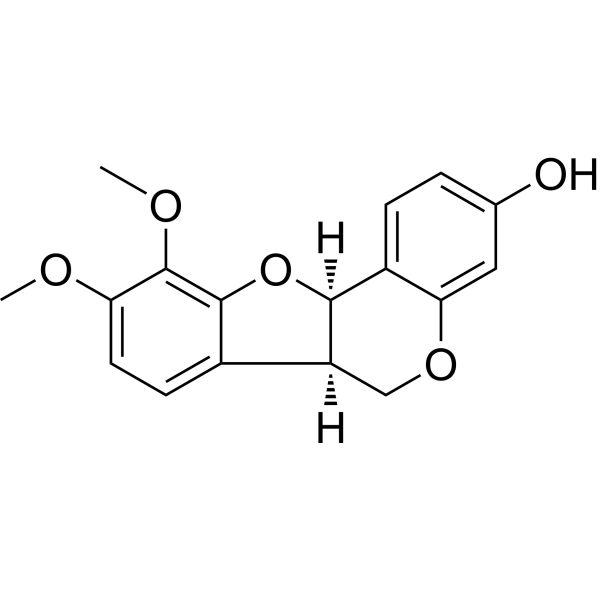
-
- HY-146741
-
|
|
Epigenetic Reader Domain
|
Cancer
|
|
SDR-04 is a BET inhibitor and exhibits strong BRD4-BD1 affinity and inhibition activity. SDR-04 potently suppresses MV4;11 cancer cell line proliferation .
|
-
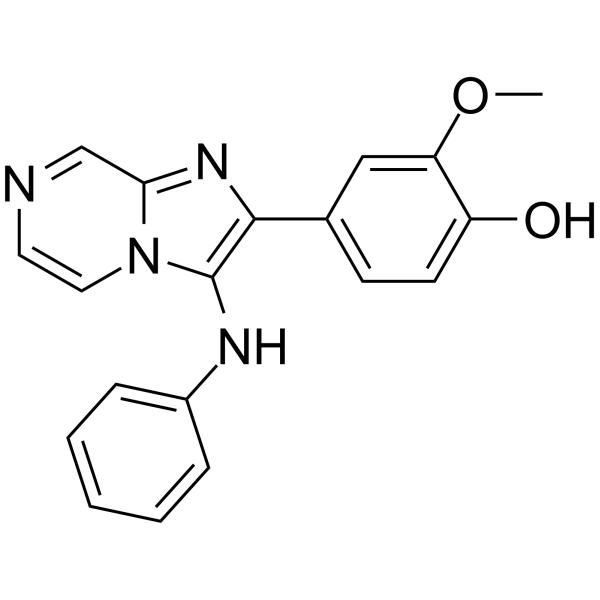
-
- HY-145256
-
|
|
GABA Receptor
|
Neurological Disease
|
|
GABAA receptor agent 4 (compound 1e) is a potent γ-GABAAR antagonist with an Ki of 0.18 µM. GABAA receptor agent 4 efficiently rescues inhibition of T cell proliferation. GABAA receptor agent 4 has the immunomodulatory potential .
|
-

-
- HY-125636
-
|
|
Others
|
Cancer
|
|
Mycro1 is an inhibitor of c-Myc/Max dimer and DNA binding, with an IC50 value of 30 μM for the inhibition of Myc/Max DNA binding activity. Mycro1 can inhibit c-myc-dependent cell proliferation, gene transcription and oncogenic transformation .
|
-
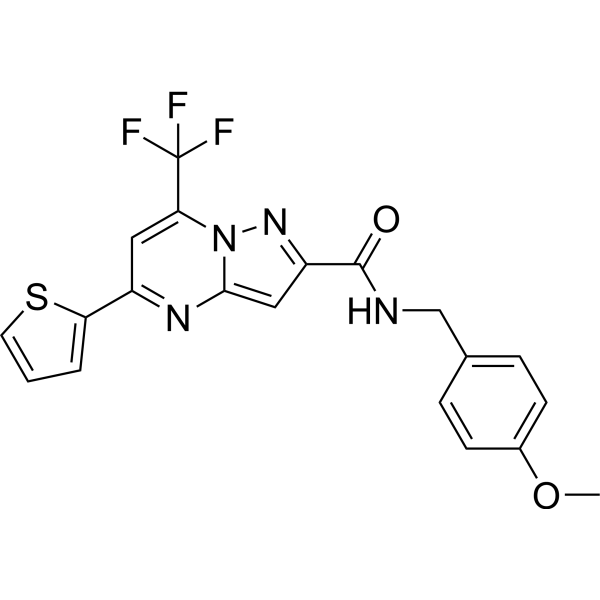
-
- HY-126979
-
|
|
Others
|
Cancer
|
|
Mycro2 is an inhibitor of c-Myc/Max dimer and DNA binding, with an IC50 value of 23 μM for the inhibition of Myc/Max DNA binding activity. Mycro2 can inhibit c-myc-dependent cell proliferation, gene transcription and oncogenic transformation .
|
-
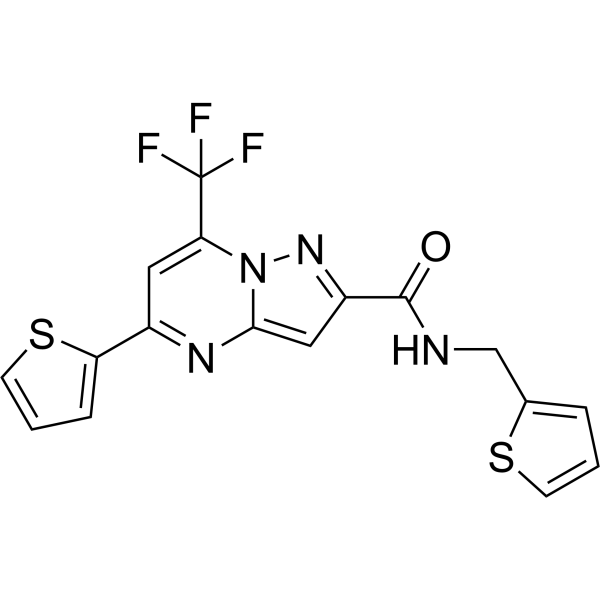
-
- HY-N0735
-
|
|
Autophagy
|
Cancer
|
|
Phellodendrine chloride is a plant alkaloid found in Phellodendron amurense. Phellodendrine chloride suppresses the proliferation of KRAS mutated pancreatic cancer cells through inhibition of nutrients uptake via macropinocytosis . Phellodendrine chloride promotes autophagy by regulating the AMPK/mTOR pathway and reduce the intestinal damage of ulcerative colitis .
|
-
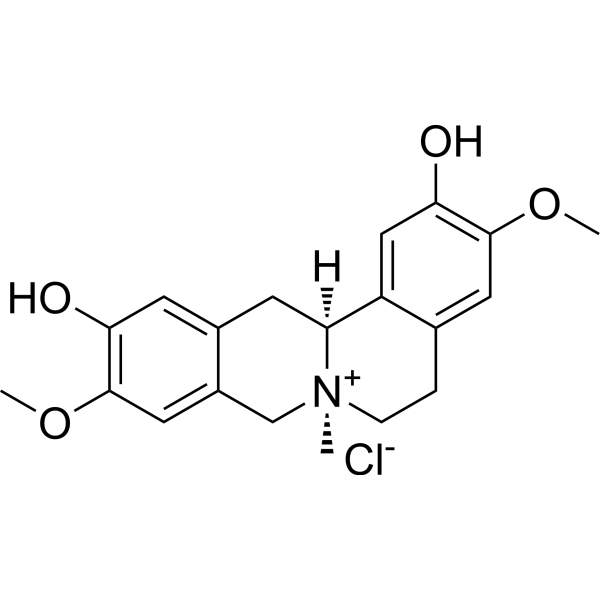
-
- HY-W800162
-
|
|
VEGFR
|
Cancer
|
|
VEGFR-2-IN-37 (compound 12) is an inhibitor of VEGFR-2. The inhibition rate at 200 μM was approximately 56.9 μM. VEGFR-2-IN-37 is a potential inhibitor of human umbilical vein endothelial cell (HUVEC) proliferation .
|
-

-
- HY-15838
-
ID-8
4 Publications Verification
|
DYRK
|
Cancer
|
|
ID-8 is an inhibitor of dual-specificity tyrosine phosphorylation-regulated kinase (DYRK). ID-8 sustains embryonic stem cell (ESC) self-renewal and pluripotency. ID-8 enhances Wnt-mediated hESC survival and proliferation via inhibition of DYRKs .
|
-
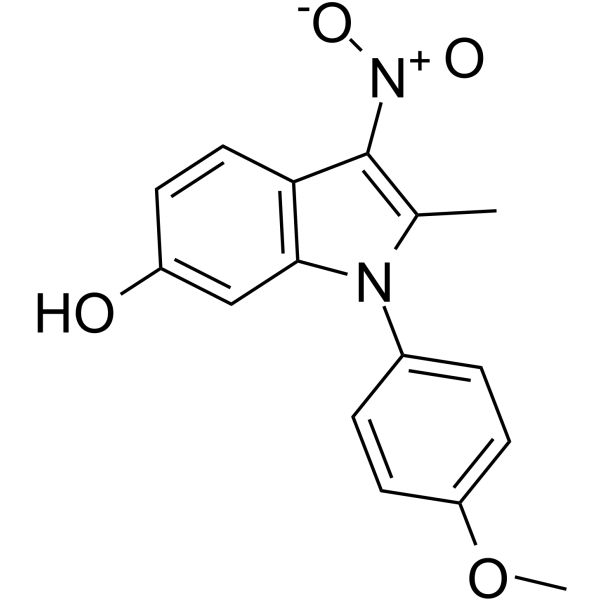
-
- HY-130257
-
|
|
PROTACs
|
Cancer
|
|
CP5V is a PROTAC connected by ligands for von Hippel-Lindau and CDK, which specifically degrades Cdc20 by linking Cdc20 to the VHL/VBC complex for ubiquitination followed by proteasomal degradation. CP5V induces mitotic inhibition and suppresses cancer cell proliferation .
|
-
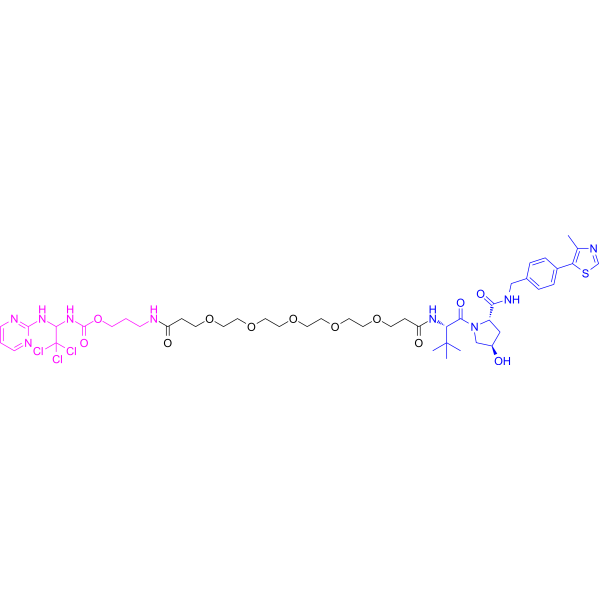
-
- HY-N0781
-
|
|
Apoptosis
|
Cancer
|
|
Linderalactone is an important sesquiterpene lactone isolated from Lindera aggregata. Linderalactone inhibits cancer growth by modulating the expression of apoptosis-related proteins and inhibition of JAK/STAT signalling pathway. Linderalactone also inhibits the proliferation of the lung cancer A-549 cells with an IC50 of 15 µM .
|
-
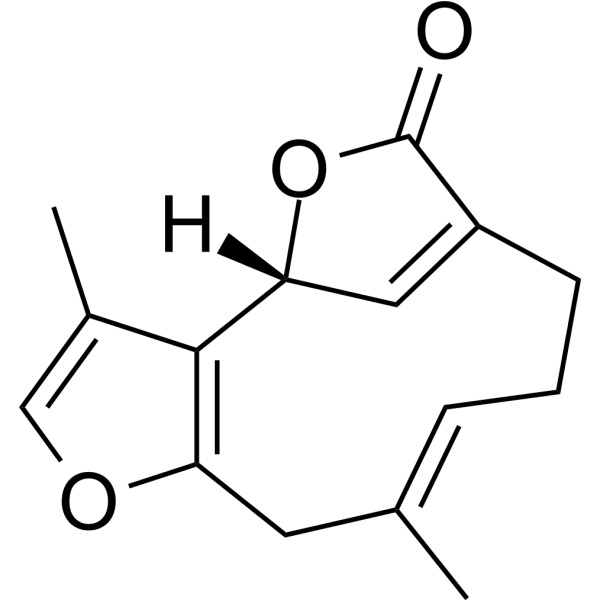
-
- HY-136895
-
|
|
Prostaglandin Receptor
|
Cancer
|
|
AZ12672857 is an orally active inhibitor of EphB4 (IC50=1.3 nM) and Src kinases. AZ12672857 shows good inhibition of proliferation of c-Src transfected 3T3 cells (IC50=2 nM) as well as autophosphorylation of EphB4 in transfected CHO-K1 cells (IC50=9 nM) .
|
-

-
- HY-N3862
-
|
|
Others
|
Cancer
|
|
Erythrodiol 3-O-palmitate is a natural product isolated from Dicranostigma leptopodum (Maxim) Fedde, Gentiana rhodantha Franch or Swertia kouitchensis. Erythrodiol 3-O-palmitate has antitumor activity, and inhibits the proliferation of K562 cells with the inhibition rate of 47% at 100 ug/mL .
|
-

-
- HY-15814
-
|
|
Bcr-Abl
PDGFR
c-Kit
Src
JAK
Apoptosis
|
Cancer
|
|
HG-7-85-01 is a type II ATP competitive inhibitor of wild-type and gatekeeper mutations forms of Bcr-Abl, PDGFRα, Kit, and Src kinases. HG-7-85-01 inhibits T315I mutant Bcr-Abl kinase, KDR and RET with IC50s of 3 nM, 20 nM and 30 nM, and is only weak or no inhibition of other kinases (IC50>2 μM). HG-7-85-01 inhibits the cell proliferation, which is mediated by the induction of apoptosis, and inhibition of cell-cycle progression .
|
-

-
- HY-N2045
-
|
|
|
|
|
Musk ketone is a widely used artificial fragrance. Musk ketone is also a cytochrome P450 enzyme inducer. Musk ketone shows mutagenic and comutagenic effects in Hep G2 cells and induces neural stem cell proliferation and differentiation in cerebral ischemia via activation of the PI3K/Akt signaling pathway. In the brain, musk ketone is neuroprotective against stroke injury through inhibition of cell apoptosis .
|
-

-
- HY-109523
-
|
|
HMG-CoA Reductase (HMGCR)
Ferroptosis
|
Cardiovascular Disease
Cancer
|
|
Cerivastatin sodium is a synthetic lipid-lowering agent and a highly potent, well-tolerated and orally active HMG-CoA reductase inhibitor, with a Ki of 1.3 nM/L. Cerivastatin sodium reduces low-density lipoprotein cholesterol levels. Cerivastatin sodium also inhibits proliferation and invasiveness of MDA-MB-231 cells, mainly by RhoA inhibition, and has anti-cancer effect .
|
-
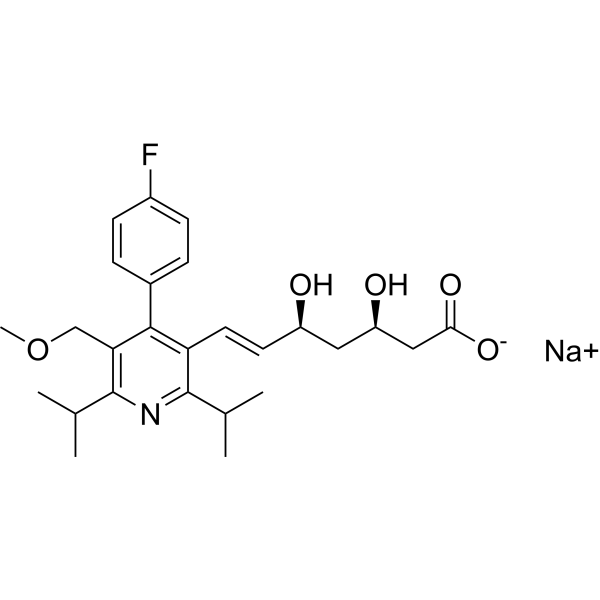
-
- HY-108350
-
|
|
Epigenetic Reader Domain
|
Cancer
|
|
MI-2-2 is a potent menin-MLL inhibitor. MI-2-2 binds to menin with low nanomolar affinity (Kd=22nM) and very effectively disrupts the bivalent protein-protein interaction between menin and MLL. MI-2-2 has specific and very pronounced activity in MLL leukemia cells, including inhibition of cell proliferation, down-regulation of Hoxa9 expression, and differentiation .
|
-
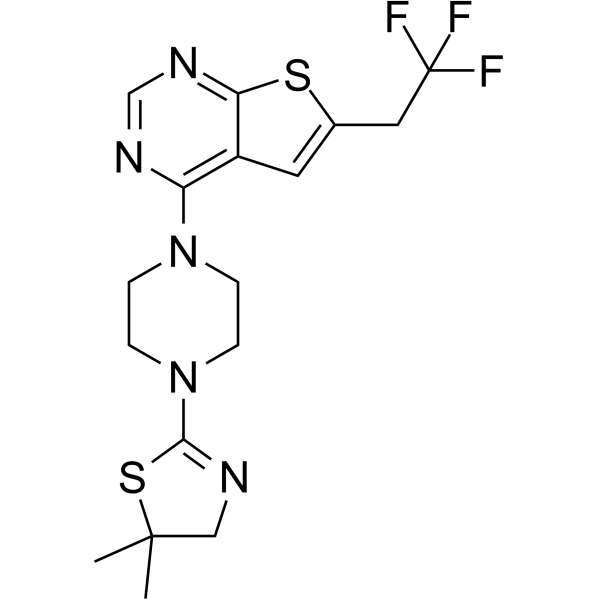
-
- HY-129458
-
|
|
HMG-CoA Reductase (HMGCR)
Ferroptosis
|
Cardiovascular Disease
Cancer
|
|
Cerivastatin is a synthetic lipid-lowering agent and a highly potent, well-tolerated and orally active HMG-CoA reductase inhibitor, with a Ki of 1.3 nM/L. Cerivastatin reduces low-density lipoprotein cholesterol levels. Cerivastatin also inhibits proliferation and invasiveness of MDA-MB-231 cells, mainly by RhoA inhibition, and has anti-cancer effect .
|
-

-
- HY-132998
-
|
|
PROTACs
|
Others
|
|
HDAC6 degrader-1 is a PROTAC that comprises a selective HDAC6 inhibitor Nexturastat A (Nex A) as the HDAC6 binder, a linker and a ligand for recruiting E3 ligase. HDAC6 degrader-1 induces significant degradation of HDAC6, exhibits excellent selectivity against other HDACs, and demonstrates efficient inhibition of cell proliferation .
|
-
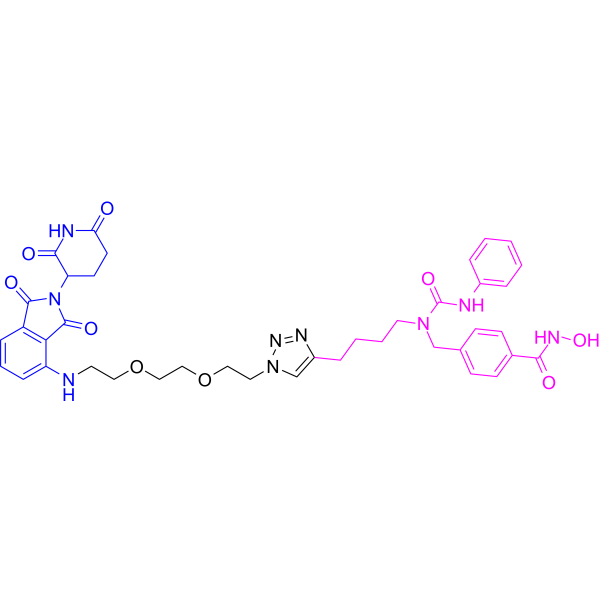
-
- HY-144825
-
|
|
Apoptosis
Reactive Oxygen Species
|
Cancer
|
|
Chol-CTPP is a ligand with dual targeting effect on blood-brain barrier (BBB) and glioma cells. Lip-CTPP can be gained by Chol-CTPP and another mitochondria targeting ligand (Chol-TPP). Lip-CTPP is a promising potential carrier to exert the anti-glioma effect of doxorubicin (DOX) and lonidamine (LND) collaboratively. Lip-CTPP elevates the inhibition rate of tumor cell proliferation, migration and invasion, promote apoptosis and necrosis, and interfere with mitochondrial function .
|
-

-
- HY-N7510
-
|
12-Methoxycarnosic acid
|
5 alpha Reductase
|
Infection
Cancer
|
|
12-O-Methylcarnosic acid (12-Methoxycarnosic acid), a diterpene carnosic acid isolated from the acetone extract of Salvia microphylla, is an active constituent of 5α-reductase inhibition with an IC50 value of 61.7 μM. 12-O-Methylcarnosic acid inhibits proliferation in LNCaP cells. 12-O-Methylcarnosic acid has antioxidant, anti-cancer and antimicrobial activity .
|
-
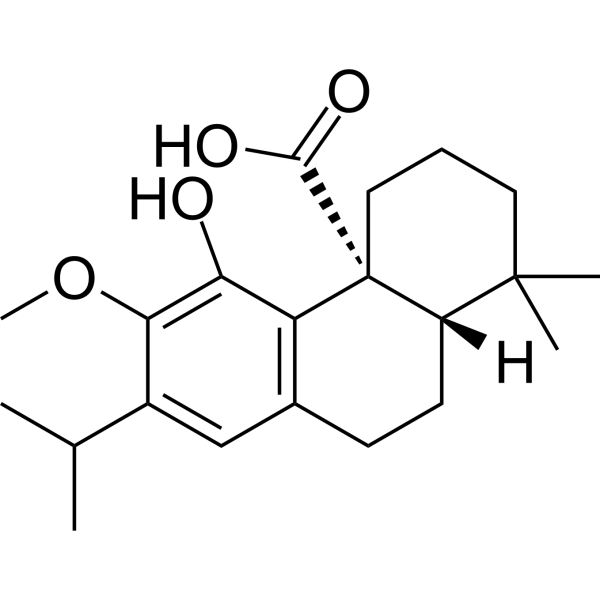
-
- HY-123714
-
|
|
MAP4K
Apoptosis
|
Inflammation/Immunology
Cancer
|
|
TL4-12 is a selective MAP4K2/GCK inhibitor, dose-dependently downregulates IKZF1 and BCL-6 and leads to MM cell proliferation inhibition (IC50=37 nM) accompanied by induction of apoptosis. TL4-12 can be used to overcome immunomodulatory agent resistance in multiple myeloma (MM) .
|
-
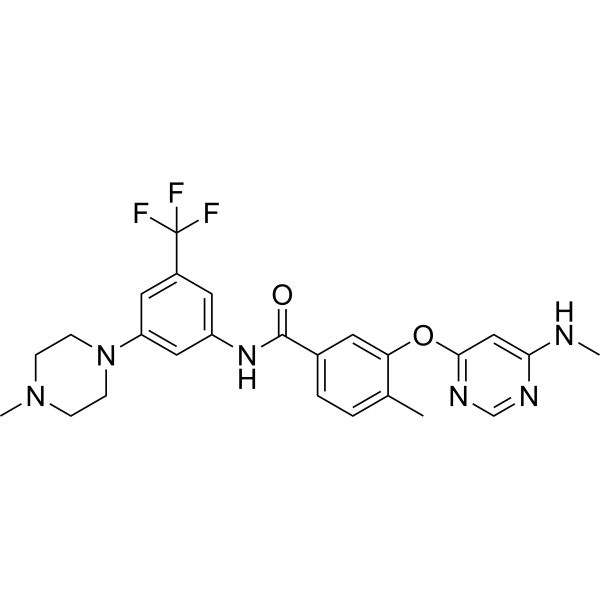
-
- HY-N1365
-
|
6-Hydroxy-7-methoxycoumarin
|
HBV
|
Infection
Cancer
|
|
Isoscopoletin (6-Hydroxy-7-methoxycoumarin) is an active constituent in Artemisia argyi leaves. Isoscopoletin shows substantial inhibition against cell proliferation, with IC50s of 4.0 μM and 1.6 μM for human CCRF-CEM leukaemia cells and multidrug resistant subline CEM/ADR5000, respectively . Isoscopoletin (6-Hydroxy-7-methoxycoumarin) possesses inhibitory activity against HBV replication .
|
-
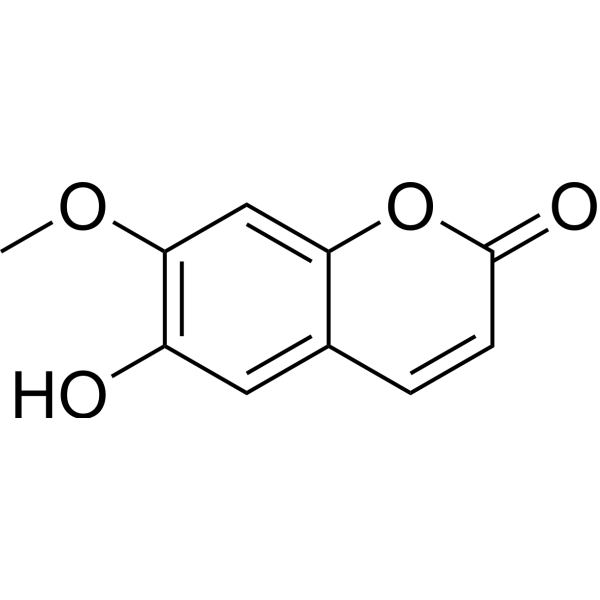
-
- HY-139434
-
|
|
Histone Demethylase
|
Cancer
|
|
JMJD6-IN-1 (Compound 1-3) is a JMJD6 inhibitor, with an inhibition rate of 82% at 10 μM. JMJD6-IN-1 inhibits MCF-7 and HCC4006 cell proliferation with IC50s of 19.2 μM and 25.2 μM. JMJD6-IN-1 can be used for research of cancers .
|
-
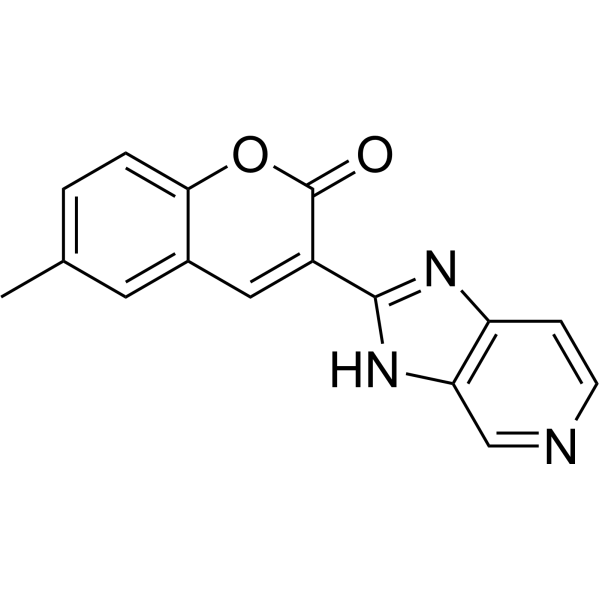
-
- HY-161409
-
|
|
Androgen Receptor
Apoptosis
|
Cancer
|
|
SC912 is an AR-V7 inhibitor (IC50 = 0.36 μM). SC912 possesses safety, potency and selectivity. SC912 binds directly to AR-FL and AR-V7 proteins, inhibites nuclear localization and chromatin binding capabilities. SC912 exerts anticancer activity through inhibition of proliferation, induction of cell cycle arrest and apoptosis .
|
-
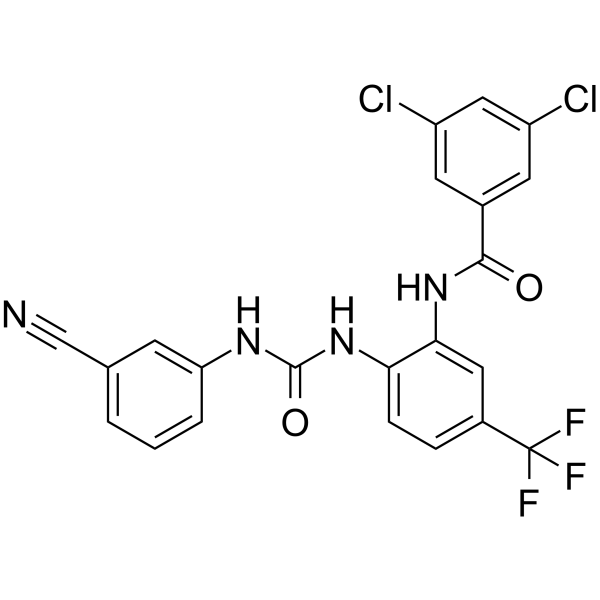
-
- HY-110247
-
|
|
TNF Receptor
NF-κB
|
Cardiovascular Disease
Inflammation/Immunology
|
|
TRAF-STOP inhibitor 6877002, is a selective inhibitor of CD40-TRAF6 interaction, compound VII, shows inhibition of NF-κB activation in RAW cells, extracted from patent WO2014033122A1 . TRAF-STOP 6877002 prevents the progression of established atherosclerosis in mice, reduces leukocyte recruitment and reduces macrophage activation; reduces macrophage proliferation in atherosclerotic plaques .
|
-
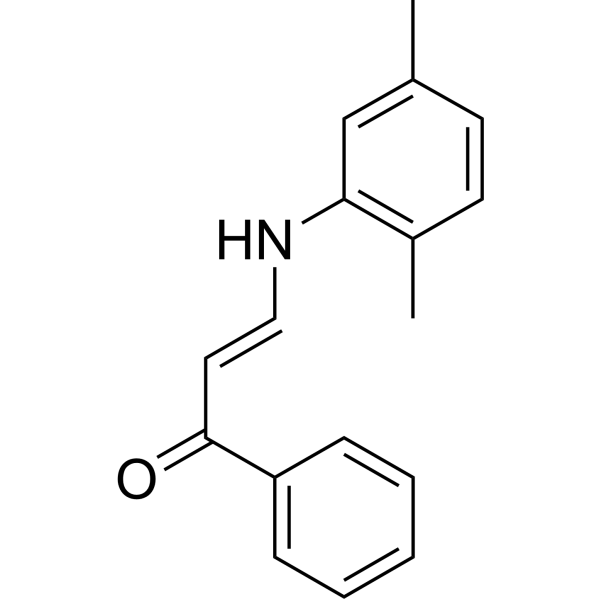
-
- HY-18696
-
|
|
c-Met/HGFR
Caspase
Apoptosis
|
Cancer
|
|
AMG-337 is a potent, orally active, selective MET kinase inhibitor with IC50 values of 1, 1, 4.7, 5, 21.5, 1077 and >4000 nM of WT MET, H1094R MET, M1250T MET, HGF-stimulated pMET (PC3 cells) MET, V1092I MET, Y1230H MET, and D1228H MET, respectively. AMG 337 inhibits the phosphorylation of MET and downstream effectors in MET-amplified cancer cell lines, resulting in an inhibition of MET-dependent cell proliferation and induction of apoptosis .
|
-

-
- HY-120323
-
|
|
TNF Receptor
|
Inflammation/Immunology
|
|
DRI-C21045 (compound 10) is a potent and selective inhibitor of the CD40-CD40L costimulatory protein-protein interaction (PPI) with an IC50 of 0.17 µM. DRI-C21045 shows concentration-dependent inhibition of the activation of NF-κB and B cell proliferation all induced by CD40L with IC50s of 17.1 µM and 4.5 µM, respectively .
|
-
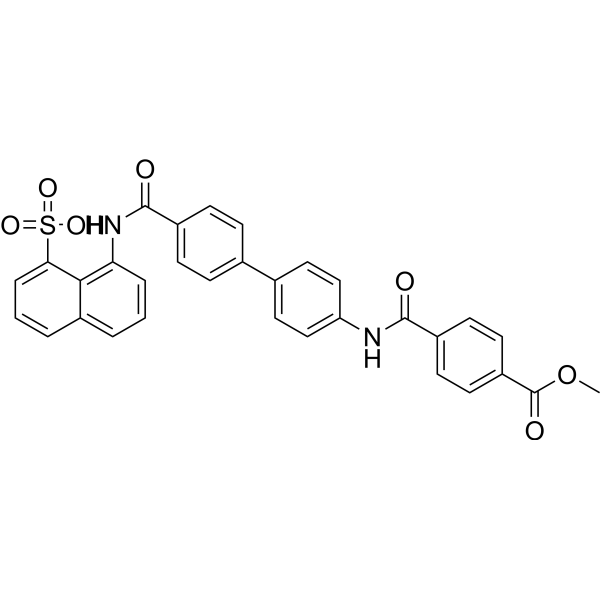
-
- HY-132231
-
|
|
PI3K
Apoptosis
|
Cancer
|
|
FD223 is a potent and selective phosphoinositide 3-kinase delta (PI3Kδ) inhibitor. FD223 displays high potency (IC50=1 nM) and good selectivity over other isoforms (IC50s of 51 nM, 29 nM and 37 nM, respectively for α, β and γ). FD223 exhibits efficient inhibition of the proliferation of acute myeloid leukemia (AML) cell lines by suppressing p-AKT Ser473 thus causing G1 phase arrest during the cell cycle. FD223 has potential for the research of leukemia such as AML .
|
-

-
- HY-158138
-
|
|
PARP
Topoisomerase
Apoptosis
|
Cancer
|
|
TOPOI/PARP-1-IN-1 (Compound B6) is an orally active, low cytotoxic TOPOI/PARP dual inhibitor with an IC50 value of 0.09 μM for PARP1. TOPOI/PARP-1-IN-1 can effectively inhibit the proliferation and migration of cancer cells. TOPOI/PARP-1-IN-1 also causes cell cycle arrest in the G0/G1 phase and induces apoptosis. The tumor growth inhibition rate (TGI) of TOPOI/PARP-1-IN-1 in mice was 75.4% .
|
-

-
- HY-155066
-
|
|
PI3K
mTOR
|
Cancer
|
|
FD274 is a highly potent PI3K/mTOR dual inhibitor with IC50s of 0.65 nM, 1.57 nM, 0.65 nM, 0.42 nM, and 2.03 nM against PI3Kα/β/γ/δ and mTOR, respectively. FD274 exhibits significant anti-proliferation of AML cell lines (HL-60 and MOLM-16). FD274 demonstrates dose-dependent inhibition of tumor growth in the HL-60 xenograft model. FD274 has the potential for acute myeloid leukemia research .
|
-
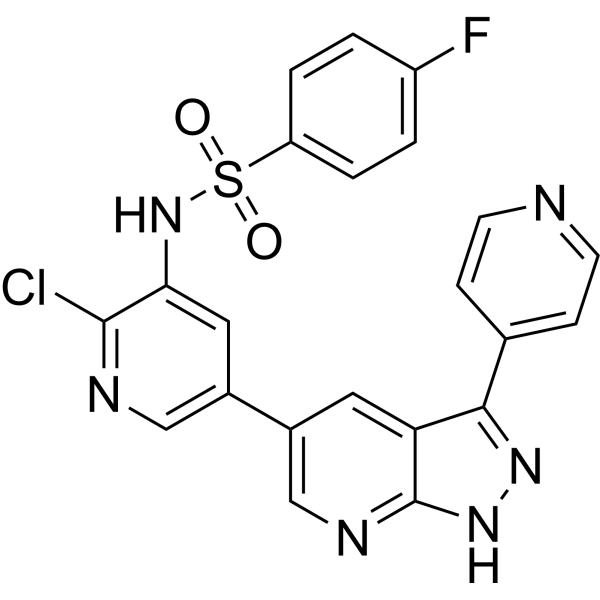
-
- HY-151137
-
|
|
mTOR
HSP
Apoptosis
Autophagy
|
Cancer
|
|
HSP90/mTOR-IN-1 is a potent and orally active Hsp90 and mTOR inhibitor with IC50 values of 69 nM and 29 nM, respectively. HSP90/mTOR-IN-1 suppresses the proliferation of SW780 cells through the over-activation of the PI3K/AKT/mTOR pathway. HSP90/mTOR-IN-1 induces apoptosis and autophagy via selective Hsp90 and mTOR inhibition. HSP90/mTOR-IN-1 also has considerable in vivo anti-tumor activity. HSP90/mTOR-IN-1 can be used for researching bladder cancer .
|
-
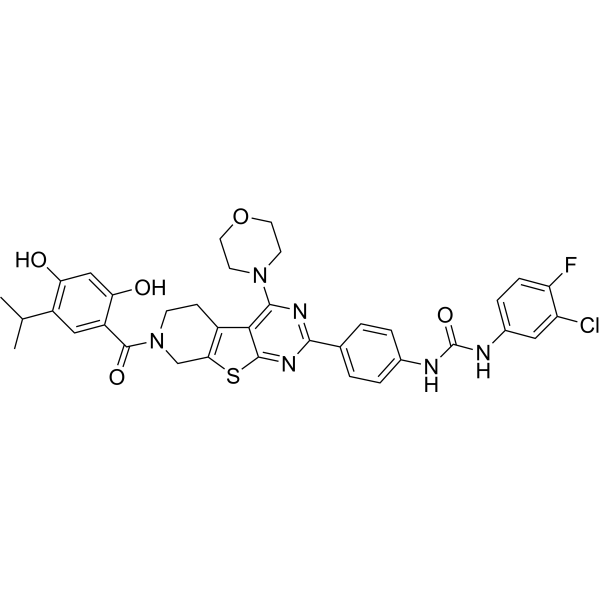
-
- HY-141582
-
|
N-Stearoyl phytosphingosine
|
Biochemical Assay Reagents
|
Others
|
|
C18 Phytoceramide (t18:0/18:0) (Cer(t18:0/18:0)) is a bioactive sphingolipid found in the stratum corneum of Saccharomyces cerevisiae, wheat grain, and mammalian epidermis. Cer(t18:0/18:0) consists of a phytosphingosine backbone amine linked to a C18 fatty acid chain. Cer(t18:0/18:0) has the function of regulating apoptosis, cell differentiation, proliferation of smooth muscle cells and inhibition of mitochondrial respiratory chain. It also suppresses the expression of allergic cytokines IL-4, TNF-α, and transcription factors c-Jun and NF-κB in histone-stimulated mouse skin tissue. Formulations containing cer(t18:0/18:0) have been used as skin protectants in cosmetics as they reduce water loss and prevent epidermal dehydration and irritation.
|
-

| Cat. No. |
Product Name |
Type |
-
- HY-141582
-
|
N-Stearoyl phytosphingosine
|
Biochemical Assay Reagents
|
|
C18 Phytoceramide (t18:0/18:0) (Cer(t18:0/18:0)) is a bioactive sphingolipid found in the stratum corneum of Saccharomyces cerevisiae, wheat grain, and mammalian epidermis. Cer(t18:0/18:0) consists of a phytosphingosine backbone amine linked to a C18 fatty acid chain. Cer(t18:0/18:0) has the function of regulating apoptosis, cell differentiation, proliferation of smooth muscle cells and inhibition of mitochondrial respiratory chain. It also suppresses the expression of allergic cytokines IL-4, TNF-α, and transcription factors c-Jun and NF-κB in histone-stimulated mouse skin tissue. Formulations containing cer(t18:0/18:0) have been used as skin protectants in cosmetics as they reduce water loss and prevent epidermal dehydration and irritation.
|
| Cat. No. |
Product Name |
Target |
Research Area |
-
- HY-P5452
-
|
|
Peptides
|
Others
|
|
PKCd (8-17) is a biological active peptide. (This peptide is derived from the V1 domain of protein kinase C (PKC)d. It inhibits phorbol 12-myristate 13-acetate (PMA)-induced PKCd translocation and activation. Inhibition of PKCd reduces ischemia damage in cardiac and cerebral cells, induces proliferation of fibroblasts, and inhibits graft coronary artery disease in mice.)
|
| Cat. No. |
Product Name |
Category |
Target |
Chemical Structure |
Your information is safe with us. * Required Fields.
Inquiry Information
- Product Name:
- Cat. No.:
- Quantity:
- MCE Japan Authorized Agent:


























































